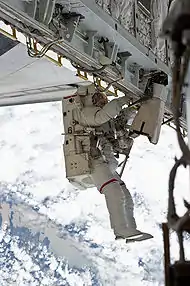Simplified Aid For EVA Rescue
Simplified Aid For EVA Rescue (SAFER) is a small, self-contained, propulsive backpack system (jet pack) worn during spacewalks, to be used in case of emergency only. If an untethered astronaut were to lose physical contact with the vessel, it would provide free-flying mobility to return to it. It is worn on spacewalks outside the International Space Station (ISS), and was worn on spacewalks outside the Space Shuttle. So far, there has not been an emergency in which it was needed.[1][2] SAFER is a small, simplified version of the Manned Maneuvering Unit (MMU), which was used for regular maneuvering.[3]


Application
SAFER is designed to be used as a self-rescue device if in spite of precautions such as tethers, safety grips, and the robot arm an EVA crewmember gets separated and no vehicles can provide rescue capability.[4] SAFER is worn by every ISS crewmember using an Extravehicular Mobility Unit.
SAFER was co-invented by former astronauts Joseph Kerwin, Paul Cottingham and Ted Christian under a Lockheed contract to NASA for Space Station Freedom. It was later sponsored by the Space Shuttle Program and developed by Lockheed and NASA personnel. SAFER was the design solution to the Shuttle Program's requirement to provide a means of self rescue should an EVA crewmember become untethered during an EVA.
SAFER was first flown on STS-64 September 9, 1994, where an untethered flight test was performed first by astronaut Mark Lee and then Carl Meade. Both astronauts flew the SAFER up and around the Shuttle's Robotic Arm along with a demonstration test of the SAFER's automatic attitude hold feature. This feature arrests uncontrolled rotation of a detached crewmember expected in an accidental separation. SAFER has a mass of approximately 83 lb (38 kg) and can provide a total change in velocity (delta-v) of at least 10 ft/s (3 m/s).[4] It was also tested during flight STS-92 when astronauts Peter Wisoff and Michael López-Alegría performed test maneuvers, flying up to 50 feet (15 m) while remaining tethered to the spacecraft.[5]
Complications
The left side latch on the SAFER unit became unlatched during an EVA by astronaut Piers Sellers on STS-121 while testing shuttle repair techniques.[6][7] The latch had been inadvertently bumped and moved to the unlatch position. As a precaution, Mike Fossum tethered it to him and the spacewalk continued.[8] In subsequent spacewalks, the latches were secured with Kapton tape, a space-rated form of adhesive tape, to prevent the latches from inadvertently opening.
See also
References
- NASA (2000). "STS-92 Day 8 Highlights". NASA. Retrieved October 6, 2008.
- APOD (2001). "Astronomy Picture of the Day A Flying Astronaut Over Earth". NASA. Retrieved October 6, 2008.
- NASA (1993). "SAFER Assembly". NASA. Archived from the original on June 13, 2011. Retrieved October 6, 2008.
- Broad, William J. (September 10, 1994). "Shuttle Soars Into Orbit to Test Device for Space Rescues". The New York Times. Retrieved October 6, 2008.
- STS-92 NASA Mission Report #15 NASA, 2008-10-18.
- Mike Schneider for the Associated Press (2006). "Duct tape suggested for spacewalk repair". NBC News. Retrieved October 6, 2008.
- Kelly Young (2006). "High drama spacewalk ends in success". New Scientist. Retrieved October 6, 2008.
- Tariq Malik (2006). "Spacewalkers Test Shuttle Heat Shield Repair Technique". Space.com. Retrieved October 6, 2008.
External links
- Suited for spacewalking a teacher's guide with activities for technology education, mathematics, and science. DIANE Publishing. p. 34. ISBN 978-1-4289-2748-3.
- Video of SAFER being attached
